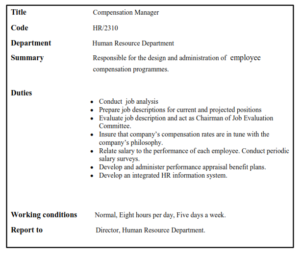Job Description
Job description is a list which containing tasks or functions and responsibility of a position which are to be performed. Job description is a written statement mentioning the job title, tasks to be performed, duties and responsibilities involved in a job. It also mentions the working conditions, hazards, stress and other problems involved in a job and the relationship with other jobs.
According to Flippo
A job description is an organized, factual statement of duties and responsibilities of a specific job. In brief, it should tell what is to be done, how it is done, and why. It is a standard of function, in that it defines the appropriate and authorized content of a job.
According to Clyde E. Witt
Job description is a document that specifies the tasks, duties and responsibilities of the job and should certainly be relevant and accurate.
According to Michael Armstrong
Job description is defined as a statement that specifies the purpose of a job, also mentions where the job fits in the organization structure, the context within which the job holder functions, and the principal accountability of job holders, or the main tasks to be carried out by them.
Contents of Job Description
A job description normally contains the following information
- Job Identification
Job title, code number of the job, department or division where the job is located. This part of job description helps to identify and designate the job. It also reveals the relationship of the job with other jobs.
- Job Summary
It describes the contents of a job in terms of the activities or tasks performed.
- Job Duties and Responsibilities
It is the heart of job description. It describes the duties performed alongwith frequency of each major duty. Responsibilities concerning custody of money, supervision and training of staff, etc. are also described in this part.
- Working Conditions
The physical environment of the job is described in terms of heat, light, noise level, dust and fumes etc. Nature of risk (hazards) and their possibility of occurrence are also given.
- Social Environment
Size of work group and inter- personal interactions required to perform the job are given. Training and development facilities may also be mentioned.
- Machines, Tools and Equipment
The names of major machine, equipment and materials used in the job are described.
- Supervision
The extent of supervision given or received is stated in terms of number of persons to be supervised along with their job titles. Designations of immediate superiors and subordinates may also be given.
- Relation to other Jobs
The jobs immediately below and above are mentioned. It provides an idea of vertical work flow and channels of promotion. It also indicates to whom the jobholder will report and who will report to him.
Specimen of Job Description
Guidelines for Preparing Job Description
- Give a clear, concise and readily understandable picture of the whole job.
- Describe in sufficient detail each of duties and responsibilities.
- Emphasize accuracy, brevity and simplicity rather than a elegant style.
- Use active verbs, e.g. type letter, sort out mail, distribute mail, train workers etc. before each statement.
- Avoid statements of opinion.
- Examples of work performed may be quoted.
- Indicate the extent of supervision received and given.
- Ensure that a new employee can understand the job by reading the job description.
Job Description must contain the following information
- Job tide, code number, department/division.
- Job contents in terms of activities or tasks performed.
- Job responsibilities to perform effectively.
- Working conditions specifying specific hazards.
- Social environment at the workplace.
- Tools and equipments required.
- Extent of supervision given and received.
- Relationship with other jobs-vertical, horizontal and diagonal.
Advantages of Job Description
- It is used to recruit and select employees in the organisation with their orientation and placement.
- It helps in crafting, training and development needs of a particular employee and developing career path.
- It plays a major role in evaluating the performance of the employee and helps in taking the decision related to promotion and transfer in an organisation.
- It is an instrument to develop work procedures and processes and help of take preventive measures to minimize the impact of hazardous conditions.
- It helps in counselling the employee and providing vocational guidance.
- It provides the basic ingredient to prepare job specification.



thanks for providing, such a good material which covers throughout the syllabus
Thanks…,u did a great job..,
Enjoyed the post.
Keep up the good work! Thanks.